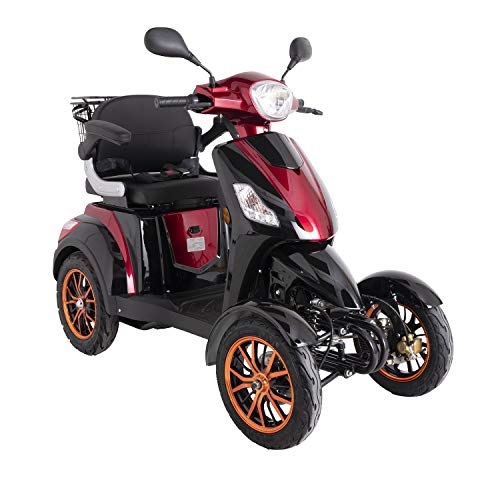10 Reasons Why People Hate Mobility Devices Mobility Devices
Raleigh
2024.12.13 00:04
227
0
본문
 Fleet Management and Smart Mobility
Fleet Management and Smart Mobility Smart mobility provides alternatives to private cars and encourages carpooling. It also helps to improve sustainability by reducing pollution and traffic.
Smart mobility provides alternatives to private cars and encourages carpooling. It also helps to improve sustainability by reducing pollution and traffic.These systems require high-speed data connectivity between devices and road infrastructure, as well as centralized systems. They also need advanced software and algorithms to process data collected by sensors and other devices.
Safety
Smart mobility solutions are available to tackle the various challenges of modern cities, including air quality, sustainability and road security. These solutions can decrease the amount of traffic congestion and carbon emissions and allow citizens to get access to transportation options. They can also help improve maintenance of the fleet and provide more convenient transportation options for users.
Since the concept of smart mobility is relatively new, there remain some hurdles to overcome before these technologies can be fully rolled out. This involves securing smart devices and infrastructures, developing user-friendly interfaces and secure measures for data security. It is also essential to comprehend the needs and preferences of different groups of users to encourage adoption.
Smart mobility's ability to integrate into existing infrastructure and systems is a key characteristic. Sensors can provide real-time data and improve the performance of systems by integrating them into vehicles roads, transportation systems, and other components. They can monitor weather conditions, traffic, and vehicle health. They can also spot road infrastructure issues, such as bridges and potholes and report them. This information can be used to optimize routes, prevent delays, and minimize the impact on motorists.
Smart mobility also has the benefit of improved fleet safety. These technologies can prevent accidents caused by human error with advanced driver alerts and crash avoidance systems. This is especially important for business owners who rely on their fleets for delivery of goods and services.
In enabling a more efficient use of transportation infrastructure and vehicles Smart mobility solutions can reduce the amount of fuel used and CO2 emissions. They also can encourage the use 3 wheel foldable electric mobility scooter vehicles, which can lead to a reduction in pollution and cleaner air. Smart mobility also offers alternatives to private vehicle ownership and encourage public transportation.
As the number of smart devices increase, a comprehensive framework for data protection is necessary to ensure security and privacy. This requires establishing clear guidelines on what data is being collected, how it is used, and who it is shared with. It also involves implementing effective security measures, regularly updating systems to protect against new threats, and ensuring transparency about practices for handling data.
Efficiency
There's no doubt that the urban mobility ecosystem is in need of a major upgrade. Congestion, pollution and wasted time are just a few things that could negatively impact business and quality of life.
Companies that offer solutions to the challenges of modern transportation and logistics are poised to profit from an ever-growing market. These solutions must also include intelligent technology to help solve key challenges such as traffic management and energy efficiency, as well as sustainability.
Smart mobility solutions are based on the idea of incorporating a range of technologies in cars and urban infrastructure to increase transportation efficiency and reduce emissions, accidents and the cost of ownership. These technologies produce a massive amount of data, which is why they need to be linked to each other and analysed in real-time.
Fortunately, many of the technologies used in transportation include connectivity features built-in. Ride-share scooters that are unlocked and rented through apps or QR codes, autonomous vehicles, and smart traffic lights are examples of this type of technology. Sensors, low-power wireless network (LPWAN) cards and eSIMs are a way to connect these devices to each other and to a central system.
Information can be shared instantly and actions can be swiftly taken to minimize issues like traffic jams or accidents. This is made possible through advanced machine learning algorithms and sensor data that analyzes data to discover patterns. These systems can also predict trouble spots in the future and provide drivers with advice on how to avoid them.
Many cities have already implemented smart mobility strategies to reduce pollution and traffic congestion. Copenhagen for instance uses intelligent traffic signs that prioritize cyclists during rush hour to reduce commute times and encourage cycling. Singapore has also introduced automated buses that navigate designated routes by using sensors and cameras to improve public transportation services.
The next phase of smart mobility will be built on advanced technology, including artificial intelligence and huge data sets. AI will enable vehicles to communicate with each with each other and with the environment around them and reduce the need for human drivers and optimizing the route of a vehicle. It will also facilitate intelligent energy management, anticipating renewable energy generation and assessing the potential risks of outages and leaks.
Sustainability
Inefficient traffic flow and air pollutants have afflicted the transportation industry for years. Smart mobility provides a solution to these problems, with numerous benefits that help improve the quality of life for people. For instance, it lets individuals to travel via public transportation systems instead of their personal vehicles. It makes it easier to locate the best electric folding mobility scooter route, and also reduces the traffic burden for users.
Smart mobility is also green and provides renewable alternatives to fossil fuels. These solutions include ride-hailing and micromobility. These solutions allow users to utilize collapsible electric mobility scooter vehicles and integrate public transportation in the city. They also reduce the need for personal vehicles, reducing CO2 emissions and improving the air quality in urban areas.
However the physical and digital infrastructure required to implement smart mobility devices is often expensive and complex. It is crucial to ensure that the infrastructure is safe and secure and is able to stand up to attacks by hackers. In addition, the system needs to be able to meet the needs of users in real-time. This requires a high level of decision autonomy, which is difficult due to the complexity and dimensionality problem space.
Additionally, a vast number of stakeholders are involved in developing smart mobility solutions. Transportation agencies, city planners and engineers are among them. All of these parties must collaborate. This will facilitate the development of more sustainable and sustainable solutions that are beneficial for the environment.
The failure of sustainable, smart mobility systems, as opposed to other cyber-physical systems like gas pipelines, could have serious environmental, social and economic consequences. This is due to the requirement to match supply and demand in real-time, the storage abilities of the system (e.g. energy storage) and the unique combination of resources within the system. Additionally, the systems are required to be able to handle large amounts of complexity as well as a large variety of possible inputs. They require a different IS driven approach.
Integration
Fleet management companies must embrace technology to be in line with the new standards. Smart mobility is a solution that offers better integration efficiency, automation, and safety in addition to boosting performance.
Smart mobility could encompass a wide range of technologies and includes everything that is connected. Ride-share scooters, which can be accessible via an app are a good example. Autonomous vehicles and other transport options are also becoming popular in recent years. However, the concept can also be applied to traffic lights, road sensors and other components of a city's infrastructure.
Smart mobility seeks to develop integrated urban transportation systems that enhance the quality of life of the people and increase productivity, reduce costs, and also have positive environmental impacts. These are often ambitious objectives that require collaboration between city planners and engineers, as along with experts in technology and mobility. The success of implementation will ultimately depend on the specific circumstances in each city.
For example the city might need to build a larger network of charging stations for Mobile Electric Scooter vehicles, or might require improvements to the bike paths and walkways to ensure safe cycling and walking. Additionally, it can benefit from smart traffic signal systems that adapt to changing conditions, reducing congestion and delays.
Local transportation operators play an important part in coordinating this initiative. They can develop applications that let users purchase tickets for public transportation as well as car-sharing and bicycle rentals on one platform. This will enable travelers to travel and encourage them to choose more sustainable transportation alternatives.
MaaS platforms allow commuters to be more flexible when traveling around the city. This is contingent upon the requirements of the moment in moment. They can decide to book a car-sharing ride for a short trip to downtown for instance, or rent an electric mobility scooter with seat for adults bike for an extended outing. These options can be combined into one app that reveals the entire route from door-to-door, and makes it easy to switch between modes of transport.
These integrated solutions are just the top of the iceberg when it comes to implementing smart mobility. In the future cities will need to connect their transportation systems, and offer seamless connections between multimodal journeys. They will require data analytics and artificial intelligence to optimize the flow of people and goods and will also need to facilitate the development of vehicles that can communicate with their surroundings.

댓글목록 0